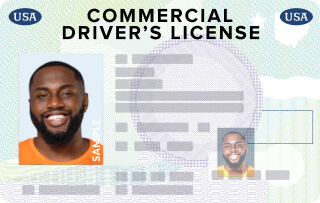- 0 Incorrect (6 allowed to pass)
- 0 Correct
- Updated for February 2025
- Based on 2025 UT commercial driver's license manual
Free Utah CDL HazMat Practice Test 2025
Utah’s mountainous regions, like the Wasatch Range with its steep grades and winter snow, and its isolated desert highways, offer professional drivers a blend of challenge and incomparably gorgeous sites. The state’s world-renowned sites, including the Mighty Five National Parks (Arches, Bryce Canyon, Canyonlands, Capitol Reef, and Zion), make every drive an adventure! By combining the skills of driving through these landscapes with the addition of the Hazardous Materials (Hazmat) endorsement to your Commercial Driver’s License (CDL), you will be prepared to handle materials the U.S. government has deemed hazardous. More importantly, this is a great way to boost your job opportunities and, potentially, your pay!
In the Beehive State, hazardous materials transported include crude oil, petroleum products, mining explosives, and industrial chemicals. Some prominent organizations in Utah include HollyFrontier Corporation (Woods Cross) (oil refining and petroleum products), Savage Services (Salt Lake City), and Rio Tinto Kennecott (South Jordan) (mining and chemical transport). All of these and more rely on drivers with this endorsement.
Now that I’ve got your attention about the advantages of obtaining the Hazmat endorsement, let’s take a look at the process required. Keep in mind, you’re about to handle dangerous materials, so the government takes this very seriously. Several steps are in place to ensure that drivers are properly trained. First you’ll need a fingerprinting and background check conducted by the Transportation Security Administration (TSA). Do not delay in this step as results from TSA can take weeks. During your wait, you should study and practice for the second step: the DMV knowledge test. This test covers federal regulations, substance handling, packaging, quantity limits, and transport configurations for hazardous materials. With successful TSA results and a score of 80% on Utah’s 30-question knowledge test, you can unlock these new opportunities (Utah CDL Handbook 2025).
Our online Utah DMV Hazmat Endorsement practice tests are designed to avoid unnecessary information and focus on what is relevant to the official test. Additionally, we have designed the content and structure of the practice tests to resemble what you will face on the official DMV test. Once you receive your TSA results and feel prepared, you’ll visit the DMV with the necessary documents, pay the fees, and pass the test. What are you waiting for? Go for it!
- Perfect for first-time and renewal CDL/CLP applicants, and those adding endorsements
- Triple-checked for accuracy
What you need to know

What to expect on the actual UT DMV exam
questions
correct answers to pass
passing score
List of questions (classic view)
- When shippers package the material, they are trying to
- What are the major differences between cargo tanks and portable tanks?
- Which of the following are necessary qualifications for non-bulk packaging?
- Which of the following hazard classes uses a transport index to determine how much of it can be loaded on a single vehicle for transport?
- What is a technical name?
- To determine if you need to use placards, you do NOT need to know
- In what location must you keep your shipping papers that describe any hazardous materials?
- Which of the following materials are acceptable floor liners for transporting Division 1.1 or 1.2 materials?
- A placarded vehicle must carry a fire extinguisher with a minimum rating of
- Do you need to stop before a railroad crossing if you are hauling 100 pounds of Division 4.3 materials?
- Where are the two main places that the hazardous material identification number appears?
- Your engine runs a pump when you are delivering compressed gas. After finishing the delivery, when should you turn off the engine?
- How often should you check the tires on a placarded trailer that has dual tires?
- If you are already carrying 100 pounds of silver cyanide, what precautions must you take if you are given papers at a dock to carry 100 cartons of battery acid?
- A safe haven is
- Which of the following three hazard classes should NOT be placed into a temperature-controlled trailer (one with a heater/air conditioner unit)?
- You must NEVER smoke or perform any activity involving fire within 25 feet of
- What is the purpose of a driver placarding his or her vehicle?
- Which of the following is NOT an acceptable type of marking for hazardous materials?
- Besides the shipping papers and the packages, the other two places where the hazardous material identification number must appear are
- The Emergency Response Guidebook (ERG)
- What action should you take if you discover your hazardous materials shipment leaking at a rest stop but there is no phone available?
- If you are carrying Division 1.2 or 1.3 materials, how far away must you park from a bridge, tunnel, or building?
- Cargo tanks are
- If you are carrying Division 1.2 or 1.3 materials, how far away must you park from the traveled portion of the roadway?
- For the hazard classes in Placard Table 2, you must use placards only if you are transporting a total of
- Which of the following hazard classes should NOT be placed into a temperature-controlled trailer (one with a heater/air conditioner unit)?
- Containment rules specify
- A hazardous material's identification number is determined by
- A truck carrying explosives has collided with another vehicle. You should not pull them apart until
- Alabama: Test 1 / Test 2
- Alaska: Test 1 / Test 2
- Arizona: Test 1 / Test 2
- Arkansas: Test 1 / Test 2
- California: Test 1 / Test 2
- Colorado: Test 1 / Test 2
- Connecticut: Test 1 / Test 2
- Delaware: Test 1 / Test 2
- District of Columbia: Test 1 / Test 2
- Florida: Test 1 / Test 2
- Georgia: Test 1 / Test 2
- Hawaii: Test 1 / Test 2
- Idaho: Test 1 / Test 2
- Illinois: Test 1 / Test 2
- Indiana: Test 1 / Test 2
- Iowa: Test 1 / Test 2
- Kansas: Test 1 / Test 2
- Kentucky: Test 1 / Test 2
- Louisiana: Test 1 / Test 2
- Maine: Test 1 / Test 2
- Maryland: Test 1 / Test 2
- Massachusetts: Test 1 / Test 2
- Michigan: Test 1 / Test 2
- Minnesota: Test 1 / Test 2
- Mississippi: Test 1 / Test 2
- Missouri: Test 1 / Test 2
- Montana: Test 1 / Test 2
- Nebraska: Test 1 / Test 2
- Nevada: Test 1 / Test 2
- New Hampshire: Test 1 / Test 2
- New Jersey: Test 1 / Test 2
- New Mexico: Test 1 / Test 2
- New York: Test 1 / Test 2
- North Carolina: Test 1 / Test 2
- North Dakota: Test 1 / Test 2
- Ohio: Test 1 / Test 2
- Oklahoma: Test 1 / Test 2
- Oregon: Test 1 / Test 2
- Pennsylvania: Test 1 / Test 2
- Rhode Island: Test 1 / Test 2
- South Carolina: Test 1 / Test 2
- South Dakota: Test 1 / Test 2
- Tennessee: Test 1 / Test 2
- Texas: Test 1 / Test 2
- Utah: Test 1 / Test 2
- Vermont: Test 1 / Test 2
- Virginia: Test 1 / Test 2
- Washington: Test 1 / Test 2
- West Virginia: Test 1 / Test 2
- Wisconsin: Test 1 / Test 2
- Wyoming: Test 1 / Test 2
Your go-to, trusted source
Experience the Driving-Tests differenceOur commitment to accuracy and quality in our practice tests
Explore our rigorous, multi-tiered verification process that ensures each question mirrors the official manual for unparalleled accuracy.

At Driving-Tests.org, we understand the importance of reliable and accurate practice tests to help you prepare for your DMV exam. That's why we've developed a meticulous process to create and continually update our practice questions, ensuring they reflect the most current driving laws and regulations.
Here's an inside look at how we maintain the highest quality in our practice tests.
Content Creation and Verification Process
- Alignment with Official Manuals:
Every question we develop is based on the most recent version of each state's official driving manual. Our team regularly monitors each state DMV's website for the latest updates to ensure our practice tests are always aligned with the most current information. - Community Feedback Integration:
We leverage feedback from our vast community of users to understand which topics are most frequently tested. This helps us focus on the areas that are most relevant and beneficial for your preparation. - Expert Content Creation:
Our in-house editor, Steven, who has extensive experience in driver education, crafts each question with precision. He conducts a thorough review of each question against the official manuals to ensure accuracy. - Rigorous Review Process:
Once Steven has finalized a set of questions, our team conducts a joint review session. This second level of scrutiny involves content accuracy, proofreading, and fact-checking to eliminate any errors. - User Feedback Mechanism:
After a question goes live on our site, we keep the lines of communication open. Each question features a feedback button, inviting users to report any issues or errors. This continuous feedback loop allows us to address and rectify any concerns promptly. - Responsive Updates:
In line with our commitment to accuracy, we quickly update our practice questions to reflect any changes in the DMV manuals. Additionally, we update the free electronic copy of the state's driver's license manuals on our site, typically within a few days after the DMV publishes them.
Our thorough quality control process ensures that you have access to practice tests that are as accurate and up-to-date as possible. We believe in the power of well-prepared drivers and are dedicated to providing you with the best study tools to help you succeed on your DMV exam.
Pass the First Time – Guaranteed
You’re moments away from your results.
Before you view them, see how 1.15 million drivers used Premium to pass faster.
Real Exam-Like Utah Questions
Get all exam-like questions seen on the real test.
99.06% Pass Rate vs. 49% Average
Most Premium users pass on their first try.
Money-Back Guarantee
We stand behind you until you pass.




